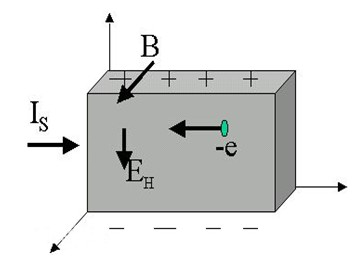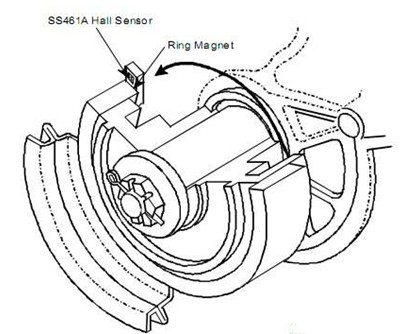
Hall Effect schematic
The Hall effect has been known and understood many years ago, but sensors based on Hall effects were not practical until significant advances in the material process took place until high-intensity constant magnets and signal conditioning circuits operating at low voltage outputs emerged. Depending on the design and configuration, Hall effect sensors can be used as on/off sensors or linear sensors and are widely used in power systems.
Honeywell is the first company to develop Hall effect technology products. For more than 30 years, the company has closely followed the changes in industrial demand and developed different types of Hall-effect technology products to meet the needs of different fields and constantly improve product performance. Honeywell’s advanced product technology has made it a global leader in control.
Honeywell Magnetic Position Sensors Product Features Honeywell's magnetic position sensors are compact and come in an ultra-small SOT-23 surface mount package; operating voltages as low as 2.7V reduce current and increase energy efficiency Built-in pull-up resistors simplify connection; built-in reverse voltage protection fully protects the integrated circuit from damage during assembly; the highly resistant design can be adapted to temperatures up to 150 degrees Celsius.
Application of SS461C Hall Effect Sensor in Automobile With the development of electronic technology, the electronic level of the car is also getting higher and higher. A good car control system can improve the adhesion between the wheels and the ground, thereby improving the safety, power and comfort of the car. The sensor is the core device in the electronic technology, and it is a device for signal conversion. Its role is to convert the measured non-electrical signal into a power signal, which is a key device to promote the overall development of automotive technology. In the automotive chassis electronic control system, the control work is inseparable from the sensor, and the speed sensor plays a major role in the vehicle control system.

Application of SS461C Hall Effect Sensor in Automobile
The SS461C Hall-effect sensor is used in speed sensors to detect the rotation of the crankshaft of an automobile or truck. The SS461C Hall-effect sensor meets the requirements of high precision and uses a digital current sink output to provide high output current and high-speed response.
Application of Hall Sensors in Brushless DC Motors The torque in DC motors is generated by the interaction between the permanent magnet field and the current in the windings. In brushed motors, the commutator achieves the armature current by switching the armature windings. Reversing with a suitable magnetic field. In the brushless DC motor, the Hall position sensor detects the position of the rotating magnetic field of the rotor and drives the corresponding winding through the logic and drive circuit. In general, the winding reacts according to the magnetic field of the permanent magnets of the motor, producing the required torque.
The main components of the brushless DC motor can be reasonably selected by the user according to the installation requirements (ie, the direction of the magnetic field of the rotor) and the sensing direction of the Hall sensor. The Honeywell SS30, SS31x/SS41x, and SS36x/SS46x series of Hall-effect sensors provide the precise motor shaft position data required for brushless DC motors.
Applications Hall-effect position integrated circuits can be used for a variety of potential applications, such as portable medical devices (kidney dialysis pumps, blood processing equipment, infusion pumps), aircraft ventilators, and marine submersible motors.
Electric Lifting Platform is one of the most popular aerial work platforms because of its strong structure, heavy duty load capacity ,simple structure and cheap price.
Introduction:
1.Moving by man manually. Lifting by AC or DC power
AC power: Connect to Socket directly.
DC power: Equipped with battery and charger.
2.Simple structure, easy to maintain.
3.Flexible producing technique, suitable for customization.
Safety precautions:
1. Explosion-proof valves
2.Equipped with antiskid plate
3.Overload protective system.
4.single control solenoid valves :prevent dropping if power failure.
5. Emergency decline valve
6.Four supporting legs
Electric Lifting Platform
Electric Lifting Platform,Electric Scissor Lift,Mobile Lifting Platform,Outdoor Lifting Platform
Shandong Lite Electrical Co.,Ltd , http://www.chinacranegroup.com
![<?echo $_SERVER['SERVER_NAME'];?>](/template/twentyseventeen/skin/images/header.jpg)